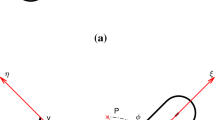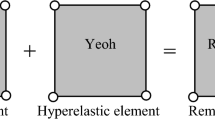Abstract
In this paper, the layout optimization problem of continuum structures embedded with movable components and holes simultaneously is solved for the first time. We propose a new methodology for the embedding problem under SIMP-based computational framework, where the positions and orientations of embedded components and holes and the topology of connecting structure are optimized concurrently to maximize the overall stiffness. To this end, the parameterized topology description function, combining the Kreisselmeier-Steinhauser (KS) function, is used to construct the geometric shapes of embedded components and holes. The material density defining the topology of connecting structure and the geometric parameters used to describe the location and orientation of embedded components and holes are considered as design variables of the optimization problem. To unite these two seemingly different representations into a single computational framework, we first project the embedded components and holes into two density fields on a fixed grid using a smoothed Heaviside function, then introduce a new SIMP-motivated material interpolation scheme invoked at the finite element level for material parameterization. The material parameterization scheme supports full analytical sensitivities, which can greatly improve the accuracy and efficiency of sensitivity analysis, and make it suitable for use with efficient gradient-based algorithms. Finally, the effectiveness of the proposed method is illustrated by several numerical examples.



















Similar content being viewed by others
Change history
26 February 2020
The original version of this article unfortunately contained a mistake. The Figure 11 in the original article should be replaced by the following figure.
References
Chen J, Shapiro V, Suresh K, Tsukanov I (2007) Shape optimization with topological changes and parametric control. Int J Numer Methods Eng 71(3):313–346
Chickermane H, Gea H (1997) Design of multi-component structural systems for optimal layout topology and joint locations. Eng Comput 13(4):235–243
Clausen A, Aage N, Sigmund O (2014) Topology optimization with flexible void area. Struct Multidiscip Optim 50(6):927–943
Gao H, Zhu J, Zhang W, Zhou Y (2015) An improved adaptive constraint aggregation for integrated layout and topology optimization. Comput Methods Appl Mech Eng 289:387–408
Guo X, Zhang W, Zhong W (2014a) Doing topology optimization explicitly and geometrically—a new moving morphable components based framework. J Appl Mech 81(8):081,009
Guo X, Zhang W, Zhong W (2014b) Stress-related topology optimization of continuum structures involving multi-phase materials. Comput Methods Appl Mech Eng 268:632–655
Hoang VN, Jang GW (2017) Topology optimization using moving morphable bars for versatile thickness control. Comput Methods Appl Mech Eng 317:153–173
Kang Z, Wang Y (2012) A nodal variable method of structural topology optimization based on Shepard interpolant. Int J Numer Methods Eng 90(3):329–342
Kang Z, Wang Y (2013) Integrated topology optimization with embedded movable holes based on combined description by material density and level sets. Comput Methods Appl Mech Eng 255:1–13
Kang Z, Wang Y, Wang Y (2016) Structural topology optimization with minimum distance control of multiphase embedded components by level set method. Comput Methods Appl Mech Eng 306:299–318
Kumar P, Saxena A (2015) On topology optimization with embedded boundary resolution and smoothing. Struct Multidiscip Optim 52(6):1135–1159
Li Q, Steven GP, Xie Y (2001) Evolutionary structural optimization for connection topology design of multi-component systems. Eng Comput 18(3/4):460–479
Li Y, Wei P, Ma H (2017) Integrated optimization of heat-transfer systems consisting of discrete thermal conductors and solid material. Int J Heat Mass Transfer 113:1059–1069
Liu T, Wang S, Li B, Gao L (2014) A level-set-based topology and shape optimization method for continuum structure under geometric constraints. Struct Multidiscip Optim 50(2):253–273
Liu J, Yu H, Ma Y (2016) Minimum void length scale control in level set topology optimization subject to machining radii. Comput Aided Des 81:70–80
Liu J, Cheng L, To AC (2017) Arbitrary void feature control in level set topology optimization. Comput Methods Appl Mech Eng 324:595–618
Liu P, Kang Z (2018) Integrated topology optimization of multi-component structures considering connecting interface behavior. Comput Methods Appl Mech Eng 341:851–887
Long K, Wang X, Gu X (2018a) Local optimum in multi-material topology optimization and solution by reciprocal variables. Struct Multidiscip Optim 57(3):1283–1295
Long K, Wang X, Gu X (2018b) Multi-material topology optimization for transient heat conduction problem using a sequential quadratic programming algorithm. Eng Optim 50(12):2091–2107
Long K, Wang X, Liu H (2019) Stress-constrained topology optimization of continuum structures subjected to harmonic force excitation using sequential quadratic programming. Struct Multidiscip Optim 59(5):1747–1759
Norato J, Bell B, Tortorelli D (2015) A geometry projection method for continuum-based topology optimization with discrete elements. Comput Methods Appl Mech Eng 293:306–327
Qian Z, Ananthasuresh G (2004) Optimal embedding of rigid objects in the topology design of structures. Mech Based Des Struct Mach 32(2):165–193
Rojas-Labanda S, Stolpe M (2016) An efficient second-order sqp method for structural topology optimization. Struct Multidiscip Optim 53(6):1315–1333
Saxena A (2011) Topology design with negative masks using gradient search. Struct Multidiscip Optim 44 (5):629–649
Sigmund O (1997) On the design of compliant mechanisms using topology optimization. J Struct Mech 25 (4):493–524
Sigmund O, Petersson J (1998) Numerical instabilities in topology optimization: a survey on procedures dealing with checkerboards, mesh-dependencies and local minima. Struct Optim 16(1):68–75
Sigmund O (2001) A 99 line topology optimization code written in matlab. Struct Multidiscip Optim 21 (2):120–127
Sigmund O (2007) Morphology-based black and white filters for topology optimization. Struct Multidiscip Optim 33(4-5):401–424
Sigmund O, Aage N, Andreassen E (2016) On the (non-)optimality of Michell structures. Struct Multidiscip Optim 54(2):361–373
Stegmann J, Lund E (2005) Discrete material optimization of general composite shell structures. Int J Numer Methods Eng 62(14):2009–2027
Svanberg K (1987) The method of moving asymptotes-a new method for structural optimization. Int J Numer Methods Eng 24(2):359–373
Wang F, Jensen JS, Sigmund O (2012) High-performance slow light photonic crystal waveguides with topology optimized or circular-hole based material layouts. Photonics Nanostruct-Fund Appl 10(4):378–388
Wang Y, Luo Z, Zhang X, Kang Z (2014) Topological design of compliant smart structures with embedded movable actuators. Smart Mater Struct 23(4):045,024
Wang X, Long K, Hoang VN, Hu P (2018) An explicit optimization model for integrated layout design of planar multi-component systems using moving morphable bars. Comput Methods Appl Mech Eng 342:46–70
Wei P, Ma H, Wang MY (2014) The stiffness spreading method for layout optimization of truss structures. Struct Multidiscip Optim 49(4):667–682
Xia L, Zhu J, Zhang W (2012a) Sensitivity analysis with the modified heaviside function for the optimal layout design of multi-component systems. Comput Methods Appl Mech Eng 241:142–154
Xia L, Zhu J, Zhang W (2012b) A superelement formulation for the efficient layout design of complex multi-component system. Struct Multidiscip Optim 45(5):643–655
Xia L, Zhu J, Zhang W, Breitkopf P (2013) An implicit model for the integrated optimization of component layout and structure topology. Comput Methods Appl Mech Eng 257:87–102
Yang K, Zhu J, Wu M, Zhang W (2018) Integrated optimization of actuators and structural topology of piezoelectric composite structures for static shape control. Comput Methods Appl Mech Eng 334:440–469
Zhang W, Zhang Q (2009) Finite-circle method for component approximation and packing design optimization. Eng Optim 41(10):971–987
Zhang J, Zhang W, Zhu J, Xia L (2012a) Integrated layout design of multi-component systems using XFEM and analytical sensitivity analysis. Comput Methods Appl Mech Eng 245:75–89
Zhang Q, Zhang W, Zhu J, Gao T (2012b) Layout optimization of multi-component structures under static loads and random excitations. Eng Struct 43:120–128
Zhang W, Xia L, Zhu J, Zhang Q (2011) Some recent advances in the integrated layout design of multicomponent systems. J Mech Des 133(10):104,503
Zhang W, Zhong W, Guo X (2015) Explicit layout control in optimal design of structural systems with multiple embedding components. Comput Methods Appl Mech Eng 290:290–313
Zhang W, Yang W, Zhou J, Li D, Guo X (2017a) Structural topology optimization through explicit boundary evolution. J Appl Mech 84(1):011,011
Zhang W, Zhao L, Gao T, Cai S (2017b) Topology optimization with closed B-splines and Boolean operations. Comput Methods Appl Mech Eng 315:652–670
Zhou M, Wang MY (2013) Engineering feature design for level set based structural optimization. Comput Aided Des 45(12):1524–1537
Zhou Y, Zhang W, Zhu J, Xu Z (2016) Feature-driven topology optimization method with signed distance function. Comput Methods Appl Mech Eng 310:1–32
Zhu J, Zhang W, Beckers P, Chen Y, Guo Z (2008) Simultaneous design of components layout and supporting structures using coupled shape and topology optimization technique. Struct Multidiscip Optim 36 (1):29–41
Zhu J, Zhang W, Beckers P (2009) Integrated layout design of multi-component system. Int J Numer Methods Eng 78(6):631–651
Zhu J, Zhang W (2010) Integrated layout design of supports and structures. Comput Methods Appl Mech Eng 199(9):557–569
Zhu J, Gao H, Zhang W, Zhou Y (2015) A multi-point constraints based integrated layout and topology optimization design of multi-component systems. Struct Multidiscip Optim 51(2):397–407
Zhu J, Zhang W, Xia L (2016) Topology optimization in aircraft and aerospace structures design. Arch Comput Methods Eng 23(4):595–622
Acknowledgments
These supports are gratefully acknowledged. The authors are also grateful to Prof. Krister Svanberg for providing the matlab MMA code, and the anonymous reviewers for their insightful suggestions and comments on the early version of this paper.
Funding
This work is supported by the National Natural Science Foundation of China (Grant Nos. 11872140, 11872017) and the Fundamental Research Funds for the Central Universities (Grant Nos. JZ2019HGBZ0127, PA2019GDPK0039, and PA2019GDQT0016).
Author information
Authors and Affiliations
Corresponding author
Ethics declarations
Conflict of interest
The authors declare that they have no conflict of interest.
Additional information
Responsible Editor: Julián Andrés Norato
Publisher’s note
Springer Nature remains neutral with regard to jurisdictional claims in published maps and institutional affiliations.
Rights and permissions
About this article
Cite this article
Wang, X., Hu, P. & Kang, Z. Layout optimization of continuum structures embedded with movable components and holes simultaneously. Struct Multidisc Optim 61, 555–573 (2020). https://doi.org/10.1007/s00158-019-02378-5
Received:
Revised:
Accepted:
Published:
Issue Date:
DOI: https://doi.org/10.1007/s00158-019-02378-5




